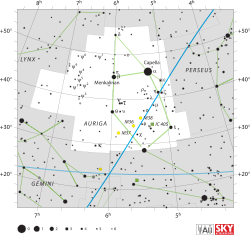Theta Aurigae

| |
| Observation data Epoch J2000 Equinox J2000 | |
|---|---|
| Constellation | Auriga |
| Right ascension | 05h 59m 43.27012s[1] |
| Declination | +37° 12′ 45.3047″[1] |
| Apparent magnitude (V) | 2.62[2] |
| Characteristics | |
| Spectral type | A0pSi + F2-5V[3] |
| U−B color index | -0.18[2] |
| B−V color index | -0.08[2] |
| R−I color index | -0.06 |
| Variable type | α2 CVn |
| Astrometry | |
| Radial velocity (Rv) | +29.5[4] km/s |
| Proper motion (μ) | RA: +43.63[1] mas/yr Dec.: -73.79[1] mas/yr |
| Parallax (π) | 19.70 ± 0.16 mas |
| Distance | 166 ± 1 ly (50.8 ± 0.4 pc) |
| Absolute magnitude (MV) | –1.05[5] |
| Details | |
| Mass | 3.38 ± 0.08[5] M☉ |
| Radius | 5.1 ± 0.4[6] R☉ |
| Luminosity | 263[5] L☉ |
| Surface gravity (log g) | 3.6 ± 0.05[6] cgs |
| Temperature | 10,400 ± 300[6] K |
| Rotation | 3.6187 days[7] |
| Rotational velocity (v sin i) | 55[6] km/s |
| Other designations | |
Theta Aurigae (θ Aur, θ Aurigae) is a binary star in the constellation Auriga. Rarely used proper names for this star include Mahasim, the latter from the Arabic المِعْصَم al-micşam "wrist" (of the charioteer), which was also used for Eta Aurigae.[8] It is known as 五車四 (the Fourth Star of the Five Chariots) in Chinese. Based upon parallax measurements, the distance to this star is about 166 light-years (51 parsecs).[1]
The primary component is a large star with more than three[5] times the mass of the Sun and over five[6] times the Sun's radius. It is radiating 263[5] times the Sun's luminosity from its outer atmosphere at an effective temperature of 10,400 K,[6] giving it the white hue of an A-type star. The star has a stellar classification of A0pSi,[3] with the 'pSi' suffix indicating it is a chemically peculiar star with an abnormal abundance of silicon.
The primary is classified an Alpha2 Canum Venaticorum type variable star and has a surface magnetic field of about 1 kG.[6] Its projected rotational velocity is 55 km s−1,[6] with the star completing a rotation in only 3.6 days.[7] The axis of rotation is inclined by an angle of 51◦ ± 6 to the line of sight from the Earth.[6]
There is a +7.2 magnitude companion, 4.5[3] magnitudes fainter than the primary, located at an angular separation of 3.91 arcseconds along a position angle of 304.9° as of 2002.[9] This is an F-type main sequence star with a stellar classification in the range F2-5 V.[3] The mean combined apparent magnitude of the system is +2.65 but the variation of the primary causes the system's brightness ranges from magnitude +2.62 to +2.70 with a period of 1.37 days. The system is an X-ray source with a luminosity of 9.49 × 1026 erg s−1.[3]
References
- 1 2 3 4 5 van Leeuwen, F. (November 2007), "Validation of the new Hipparcos reduction", Astronomy and Astrophysics, 474 (2): 653–664, arXiv:0708.1752
 , Bibcode:2007A&A...474..653V, doi:10.1051/0004-6361:20078357
, Bibcode:2007A&A...474..653V, doi:10.1051/0004-6361:20078357 - 1 2 3 Johnson, H. L.; et al. (1966). "UBVRIJKL photometry of the bright stars". Communications of the Lunar and Planetary Laboratory. 4 (99). Bibcode:1966CoLPL...4...99J.
- 1 2 3 4 5 Schröder, C.; Schmitt, J. H. M. M. (November 2007), "X-ray emission from A-type stars", Astronomy and Astrophysics, 475 (2): 677–684, Bibcode:2007A&A...475..677S, doi:10.1051/0004-6361:20077429
- ↑ Evans, D. S. (June 20–24, 1966), Batten, Alan Henry; Heard, John Frederick, eds., The Revision of the General Catalogue of Radial Velocities, University of Toronto: International Astronomical Union, Bibcode:1967IAUS...30...57E, retrieved 2009-09-10
- 1 2 3 4 5 North, P. (June 1998), "Do SI stars undergo any rotational braking?", Astronomy and Astrophysics, 334: 181–187, arXiv:astro-ph/9802286
 , Bibcode:1998A&A...334..181N
, Bibcode:1998A&A...334..181N - 1 2 3 4 5 6 7 8 9 Shulyak, D.; et al. (March 2007), "The Lorentz force in atmospheres of CP stars: θ Aurigae", Astronomy and Astrophysics, 464 (3): 1089–1099, arXiv:astro-ph/0612301
 , Bibcode:2007A&A...464.1089S, doi:10.1051/0004-6361:20064998
, Bibcode:2007A&A...464.1089S, doi:10.1051/0004-6361:20064998 - 1 2 Rice, J. B.; Holmgren, D. E.; Bohlender, D. A. (September 2004), "The distribution of oxygen on the surface of the Ap star θ Aur. An abundance Doppler image to compare with ɛ UMa", Astronomy and Astrophysics, 424: 237–244, Bibcode:2004A&A...424..237R, doi:10.1051/0004-6361:20035639
- ↑
- ↑ Roberts, Lewis C., Jr. (May 2011), "Astrometric and photometric measurements of binary stars with adaptive optics: observations from 2002", Monthly Notices of the Royal Astronomical Society, 413 (2): 1200–1205, arXiv:1012.3383
 , Bibcode:2011MNRAS.413.1200R, doi:10.1111/j.1365-2966.2011.18205.x
, Bibcode:2011MNRAS.413.1200R, doi:10.1111/j.1365-2966.2011.18205.x